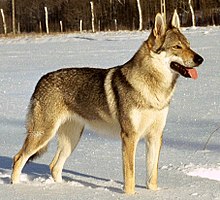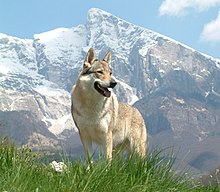Czechoslovakian Wolfdog
This article includes a list of general references, but it lacks sufficient corresponding inline citations. (March 2012) |
| Czechoslovakian Wolfdog | |||||||||||||||||||||||||||||
|---|---|---|---|---|---|---|---|---|---|---|---|---|---|---|---|---|---|---|---|---|---|---|---|---|---|---|---|---|---|
 Typical female | |||||||||||||||||||||||||||||
| Other names | Czechoslovakian Vlcak | ||||||||||||||||||||||||||||
| Origin | Czechoslovakia | ||||||||||||||||||||||||||||
| |||||||||||||||||||||||||||||
| |||||||||||||||||||||||||||||
| Notes | The AKC currently links to the FCI for breed standard | ||||||||||||||||||||||||||||
| Dog (domestic dog) | |||||||||||||||||||||||||||||
The Czechoslovakian Wolfdog,[1](sk. Československý vlčiak, cz. Československý vlčák) is a relatively new dog breed that traces its original lineage to an experiment conducted in 1955 in Czechoslovakia. After initially breeding working line German Shepherd Dogs with Carpathian wolves (Canis lupus lupus), a plan was worked out to create a breed that would have the temperament, pack mentality, and trainability of the German Shepherd Dog and the strength, physical build, and stamina of the Carpathian wolf.
The breed was engineered as attack dogs for use in military Special Operations done by the Czechoslovak Special Forces commandos but were later also used in search and rescue, schutzhund, tracking, herding, agility, obedience, hunting, and drafting in Europe and the United States. It was officially recognized as a national breed in Czechoslovakia in 1982. Officially recognized as a breed by FCI in 1989.
History

In 1955 Ing. Karel Hartl began to consider crossing Carpathian wolf with a German Shepherd. Initially, the crossing was conducted as a scientific experiment. A few years later, however, the idea was born to cultivate a new breed. The first hybrids of a female wolf Brita and male German Shepherd Cézar was born on 26 May 1958, in Libějovice.
Puppies of the first generation resembled the wolf in appearance and behavior. Their upbringing was difficult, training was possible, but the results hardly matched the effort. In adulthood they were again bred with German Shepherds, so in the fourth final generation decreased the proportion of "wolf blood" up to 6.25%. Most individuals of the third and fourth generation were able to attend a normal course and could be placed in a service performance. Compared to dogs, they had better navigational skills, night vision, hearing and sense of smell. In tests of endurance, hybrids finished the entire 100 km route without being exhausted.
The lecture of Ing. Karel Hartl "Results of crossing wolves with dogs" brought major attention at the World Dog Show held in June 1965 in Brno and in Prague at the annual meeting of the Fédération Cynologique Internationale (FCI) and the International Cynologic Congress. In the following year Ing. Hartl compiled a draft of a standard of a new dog breed. The wolf Brita then gave the basis of the second line after the merger with the German Shepherd Kurt. The third line was made by joining the wolf Arga with female dog Asta from the SNB. In 1977, the individual of the 3rd generation named Xela of border guards, was covered by wolf Sarika, he then also mated female Urta of border guards. Last addition of wolf blood took place in 1983. The wolf Lejdy of ZOO Hluboká nad Vltavou gave birth to last line of a new breed, the father of the puppies became a German Shepherd Bojar von Shottenhof. Furthermore, breeding has been carried out only in closed populations and the hybrids began to be referred to as Czechoslovakian wolfdogs.
In 1982 it was recognized by the Czechoslovakian breeders associations as a national breed. In 1989 it became FCI standard no. 332, group 1, section 1. It won the title of "World champion" at World Dog Show in Brno in 1990. Ten years after the recognition of the FCI standard, the breed had to again confirm that the breed is further viable and met all the criteria. The recognition of the Czechoslovakian wolfdog breed has been definitively confirmed.
As of January 2014, most puppies a year are registered in Italy (up to two hundred), in the Czech Republic it's about hundred and in Slovakia it's about fifty.[2]
Appearance
Both the build and the hair of the Czechoslovakian Wolfdog are reminiscent of a wolf. The lowest dewlap height is 65 cm (26 in) for a male and 60 cm for a female and there is no upper limit. The body frame is rectangular, ratio of the height to length is 9:10 or less. They typically weigh around 54 pounds (26 kg) for males and 44 pounds (20 kg) for females. The expression of the head must indicate the sex. Amber eyes set obliquely and short upright ears of a triangle shape are its characteristic features. The set of teeth is complete (42); very strong; both scissors-shaped and plier-shaped setting of the dentition is acceptable. The spine is straight, strong in movement, with a short loin. The chest is large, flat rather than barrel-shaped. The belly is strong and drawn in. The back is short, slightly sloped, the tail is high set; when freely lowered it reaches the tarsuses. The fore limbs are straight, and narrow set, with the paws slightly turned out, with a long radius and metacarpus. The hind limbs are muscular with a long calf and instep.

The color of the hair is from yellow-grey to silver-grey, with a light mask. The hair is straight, close and very thick. The Czechoslovakian Wolfdog is a typical tenacious canterer; its movement is light and harmonious, its steps are long.
Temperament
The Czechoslovakian Wolfdog is more versatile than specialized. It is quick, lively, very active, and courageous. Distinct from the character of the Saarloos Wolfhound, shyness is a disqualifying fault in the Czechoslovakian Wolfdog.
The Czechoslovakian Wolfdog develops a very strong social relationship - not only with their owner, but with the whole family. It can easily learn to live with other domestic animals which belong to the family; however, difficulties can occur in encounters with strange animals. It is vital to subdue the Czechoslovakian Wolfdog's passion for hunting when they are puppies to avoid aggressive behavior towards smaller animals as an adult. The puppy should never be isolated in the kennel; it must be socialized and get used to different surroundings. Female Czechoslovakian Wolfdogs tend to be more easily controllable, but both genders often experience a stormy adolescence.

The Czechoslovakian Wolfdog is very playful, temperamental, and learns easily. However, it does not train spontaneously, the behavior of the Czechoslovakian Wolfdog is strictly purposeful - it is necessary to find motivation for training. The most frequent cause of failure is usually the fact that the dog is tired out with long useless repetitions of the same exercise, which results in the loss of motivation. These dogs have admirable senses and are very good at following trails. They are very independent and can cooperate in the pack with a special purposefulness. If required, they can easily shift their activity to the night hours. Sometimes problems can occur during their training when barking is required. Czechoslovakian Wolfdogs have a much wider range of means of expressing themselves and barking is unnatural for them; they try to communicate with their masters in other ways (mainly through body language, but also with quiet noises such as growls, grunts, and whining). Generally, teaching the Czechoslovakian Wolfdog stable and reliable performance takes a bit longer than teaching traditional specialized breeds. The Czechoslovakian Wolfdog has been successfully employed as a Search And Rescue (SAR) dog in Italy, although, admittedly, handling one requires much more work than other breeds.
External links
- Site dedicated to statistics on the breed
- Klub chovateľov československého vlčiaka Slovenskej republiky (KCHČSV SR)
- Klub chovatelů československého vlčáka CR
References
- ^ FCI-Standard N° 332 / 03. 09. 1999 / GB
- ^ Centrum.cz - Československý vlčák
